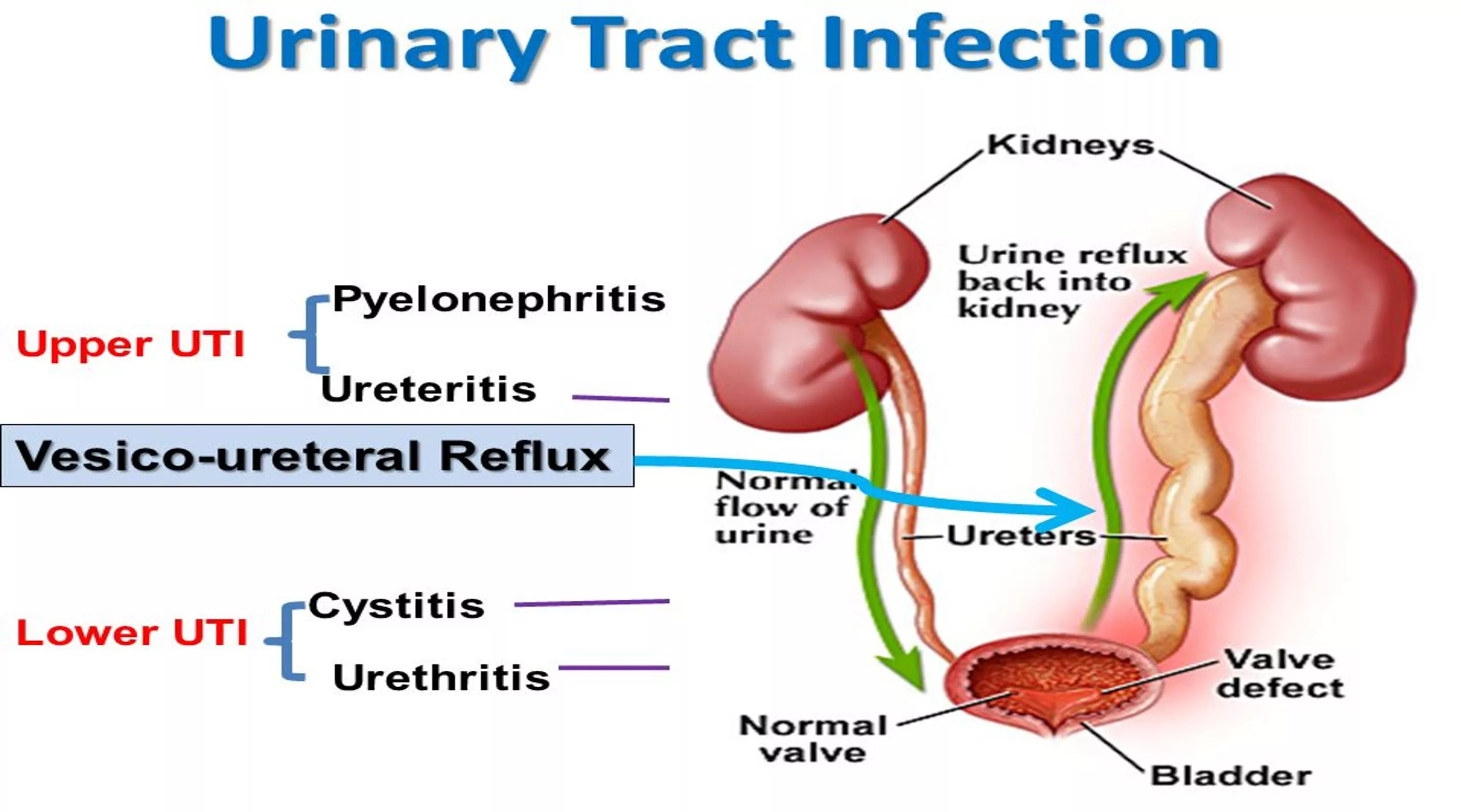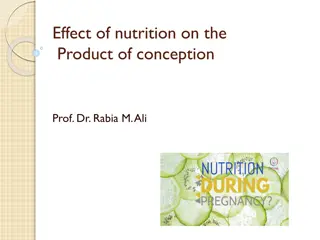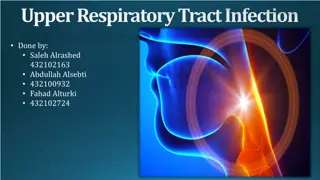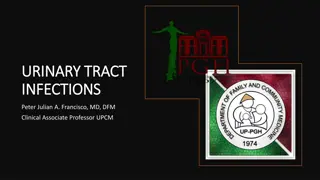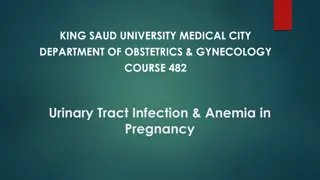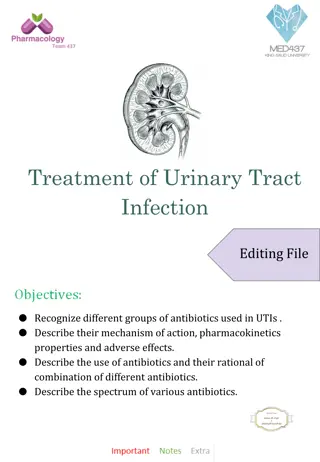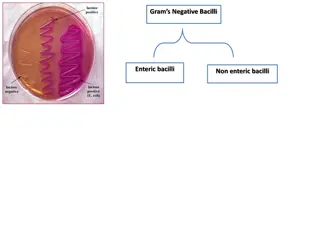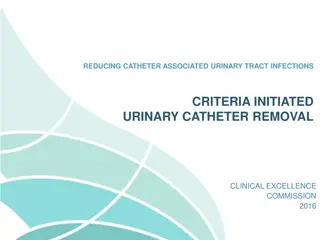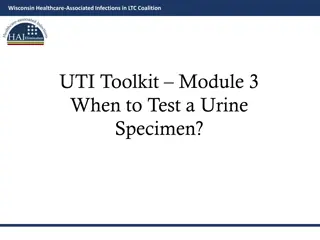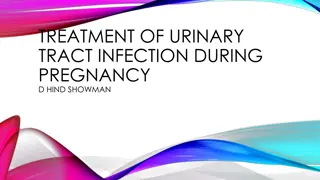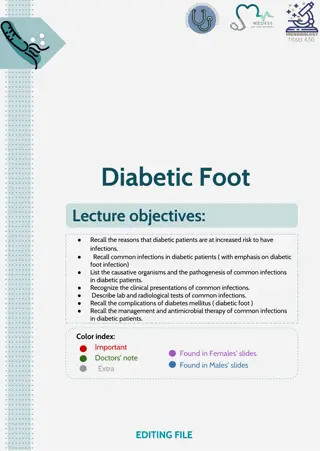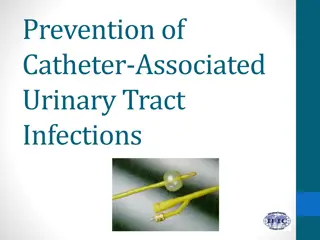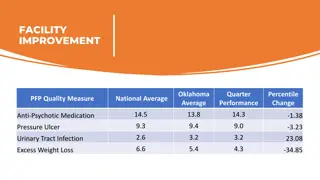Understanding Urinary Tract Infections During Pregnancy
Urinary tract infections are common bacterial infections during pregnancy, with asymptomatic bacteriuria being prevalent. If left untreated, asymptomatic bacteriuria can lead to symptomatic infection, but proper treatment with antimicrobial agents can prevent complications. Treatment options include single-dose and 3-day courses of antibiotics. Cystitis and urethritis are also discussed as potential complications of UTIs in pregnant women.
Download Presentation

Please find below an Image/Link to download the presentation.
The content on the website is provided AS IS for your information and personal use only. It may not be sold, licensed, or shared on other websites without obtaining consent from the author. Download presentation by click this link. If you encounter any issues during the download, it is possible that the publisher has removed the file from their server.
E N D
Presentation Transcript
Urinary Tract Infection Dr.Zeena Helmi
Urinary tract infection are the most common bacterial infections during pregnancy. asymptomatic bacteriuria is the most common, symptomatic infection includes cystitis, or it may involve the renal calyces, pelvis, and parenchyma pyelonephritis. Organisms that cause urinary infections are those from the normal perineal flora. Approximately 90 percent of Escherichia coli
Asymptomatic Bacteriuria is refers to persistent, actively multiplying bacteria within the urinary tract in asymptomatic women. Bacteriuria is typically present at the first prenatal visit. An initial positive urine culture result prompts treatment, after which, fewer than 1 percent of women develop a urinary tract infection. A clean-voided specimen containing more than 100,000 organisms/mL is diagnostic.
Significance If asymptomatic bacteriuria is not treated, approximately 25 percent of infected women will develop symptomatic infection during pregnancy. Eradication of bacteriuria with antimicrobial agents prevents most of these. Treatment Bacteriuria responds to empirical treatment with any of several antimicrobial regimens
treatment Single-dose treatment Amoxicillin, 3 g Ampicillin, 2 g Cephalosporin, 2 g Nitrofurantoin, 200 mg
3-day course Amoxicillin, 500 mg three times daily Ampicillin, 250 mg four times daily Cephalosporin, 250 mg four times daily Nitrofurantoin, 50 to 100 mg four times daily or 100 mg twice daily
Cystitis and Urethritis Cystitis is characterized by dysuria, urgency, and frequency, but with few associated systemic findings. Pyuria and bacteriuria are usually found. Microscopic hematuria is common, and occasionally there is gross hematuria from hemorrhagic cystitis . Although cystitis is usually uncomplicated, the upper urinary tract may become involved by ascending infection. Almost 40 percent of pregnant women with acute pyelonephritis have preceding symptoms oflower tractinfection.
Women with cystitis respond readily to anyof several regimens. Most of the three-dayregimens are usually 90-percent efective.. Lower urinary tract symptoms with pyuria accompanied by a sterile urine culture may be from urethritis caused by Chlamydia trachomatis. Mucopurulent cervicitis usually coexists, and azithromycin therapy is efective.
Acute Pyelonephritis Renal infection is the most common serious medical complication of pregnancy Clinical findings: 1-Renal infection develops more frequently in the second trimester, and nulliparity and young age are associated risk factors Pyelonephritis is unilateraland right-sidedin more than half of cases, there is usually a rather abrupt onset with fever, shaking chills,
aching pain in one or both lumbar regions. Anorexia, nausea, and vomiting may worsen dehydration. Tendernessusually can be elicited by percussion in one or both costovertebral angles.
Investigation 1. urinary sediment contains many leukocytes, frequently in clumps, and numerous bacteria. 2. Bacteremia is demonstrated in 15 to 20 percent of these women. E coli is isolated from urine or blood in 70 to 80 percent of infections, Klebsiella pneumoniae in 3 to 5 percent, Enterobacter or Proteus species in 3 to 5 percent, and gram-positive organisms, including group B Streptococcus and S aureus, in up to 10 percent of cases 3. Plasma creatinine is monitored because early studies reported that 20 percent of pregnant women developed renal dysfunction.
DDx: 1. labour 2. chorioamnionitis 3. appendicitis 4. placental abruption 5. infarcted leiomyoma.
complications 1-Uterine activity from endotoxin is common and isrelated to feverseverity 2-Varying degrees of respiratory insufficiency from endotoxin-induced manifest in up to 10 percent of women and may resultin frank pulmonary edema alveolar injury are
3-Endotoxin-induced hemolysis is common, and approximately a third of patients with pyelonephritis develop anemia . With recovery, hemoglobin regeneration is normal because erythropoietin production 4-Plasma creatinine is monitored because 20 percent of pregnant women developed renal dysfunction. acute infection does not affect
Management 1-Admission to hospital 2- Intravenous hydration to ensure adequate urinary output is the cornerstone of treatment 3- Antimicrobial therapy usually is empirical, and ampicillin plus gentamicin; cefazolin or ceftriaxone 4- High fever should be lowered with a cooling blanket or acetaminophen. is especially important in early pregnancy because of possible teratogenic effects of hyperthermia
5-Obtain urine and blood cultures 6-Evaluate hemogram, electrolytes 7-Monitor vital signsfrequently 8-Obtain chest radiograph if there is dyspnea or tachypnea serum creatinine, and
9-Repeat hematology and chemistry studies in 48 hours 10-Change to oral antimicrobialswhen afebrile 11-Discharge when afebrile 24 hours, consider antimicrobialtherapy for 7 to 10 days 12-Repeat urine culture 1 to 2 weeks after antimicrobialtherapy completed
With persistent spiking fever or lack of clinical improvement by 48 to 72 hours, urinary tract obstruction complication or both are considered. Renal sonography is recommended to search for obstruction manifest by abnormal ureteral or pyelocaliceal dilatation or another
If stones are strongly suspected patient should be sendfor 1-a renal sonographic examination , 2-a plain abdominal radiograph (will identify nearly 90 percent.) 3-MR imaging may disclose the cause of persistent infection
Obstruction relief is important, and one method is double-J ureteralstent 2percutaneous nephrostomy 3surgical removal of stones may be required in some women 1cystoscopic placement of a
for recurrence infection : nitrofurantoin, 100 mg orally at bedtime given for the remainder of the pregnancy, reduces bacteriuriarecurrence
Quiz PatintG1P0 gestational age is 20 week presented with loin pain fever and chills

 undefined
undefined



